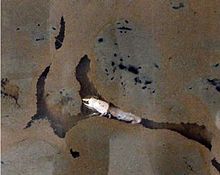| Neotrypaea californiensis | |
|---|---|

| |
| An individual in its burrow | |
| Scientific classification | |
| Domain: | Eukaryota |
| Kingdom: | Animalia |
| Phylum: | Arthropoda |
| Class: | Malacostraca |
| Order: | Decapoda |
| Suborder: | Pleocyemata |
| Family: | Callianassidae |
| Genus: | Neotrypaea |
| Species: | N. californiensis
|
| Binomial name | |
| Neotrypaea californiensis (Dana, 1854)
| |
| Synonyms [1][2] | |
| |
Neotrypaea californiensis (formerly Callianassa californiensis), the Bay ghost shrimp, is a species of ghost shrimp that lives on the Pacific coast of North America. It is a pale animal which grows to a length of 11.5 cm (4.5 in). One claw is bigger than the other, especially in males, and the enlarged claw is thought to have a function in mating. N. californiensis is a deposit feeder that lives in extensive burrow systems, and is responsible for high rates of bioturbation. It adversely affects oyster farms, and its numbers are controlled in some places by the application of pesticides. It carries out an important role in the ecosystem, and is used by fishermen as bait.
- ^ "Callianassa californiensis Dana, 1854". Integrated Taxonomic Information System. Retrieved August 17, 2011.
- ^ Lipke B. Holthuis (1991). "Callianassa californiensis". Marine Lobsters of the World. FAO Species Catalogue. Vol. 13. Food and Agriculture Organization. pp. 244–245. ISBN 978-92-5-103027-1. Archived from the original on 2011-06-07. Retrieved 2010-05-25.